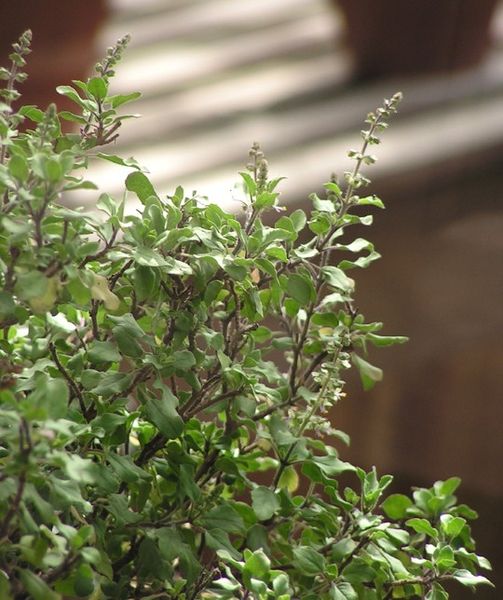Tulsi


Tulsi leaves are an essential part in the worship of Vishnu and his avatars, including Krishna and Ram, and other male Vaishnava deities such as Hanuman, Balarama, Garuda and many others. It is a sacred plant for Hindus and is worshipped as the avatar of Lakshmi. It is believed that water mixed with the petals given to the dying raises their departing souls to heaven. Tulsi, which is Sanskrit for "the incomparable one", is most often regarded as a consort of Krishna in the form of Lakshmi. According to the Brahma Vaivarta Purana, she is an expression of Sita.
There are two types of tulsi worshipped in Hinduism: "Rama tulsi" has light green leaves and is larger in size; "Shyama tulsi" has dark green leaves and is important for the worship of Hanuman. Many Hindus have tulasi plants growing in front of or near their home, often in special pots. Traditionally, it is planted in the centre of the central courtyard of Hindu houses. It is also frequently grown next to Hanuman temples, especially in Varanasi.
According to Vaishnavas, it is believed in Puranas that during Samudra Manthana, when the gods win the ocean-churning against the asuras, Dhanvantari comes up from the ocean with Amrit in hand for the gods. Dhanvantari, the divine healer, sheds happy tears, and when the first drop falls in the Amrit, it forms tulasi. In the ceremony of Tulsi Vivaha, tulsi is ceremonially married to Krishna annually on the eleventh day of the waxing moon or twelfth of the month of Kartik in the lunar calendar.
This day also marks the end of the four-month Chaturmas, which is considered inauspicious for weddings and other rituals, so the day inaugurates the annual marriage season in India. The ritual lighting of lamps each evening during Kartik includes the worship of the tulsi plant, which is held to be auspicious for the home. Vaishnavas especially follow the daily worship of tulsi during Kartik. In another legend, she was a pious woman who sought a boon to marry Vishnu. Lakshmi, Vishnu's consort, cursed her to become a plant in earth. However, Vishnu appeased her by giving her a boon that she would grace him when he appears in the form of Shaligrama in temples.
Vaishnavas traditionally use Hindu prayer beads made from tulsi stems or roots, which are an important symbol of initiation.Her rosaries are considered to be auspicious for the wearer, and believed to put them under the protection of Hanuman. They have such a strong association with Vaishnavas, that followers of Hanuman are known as "those who bear the tulsi round the neck".